Chapter 12: Report Writing Situations
Venecia Williams
Learning Objectives
- Examine common types of business reports
- Learn the organization of conference and summary reports
- Understand how to write a progress report
- Understand the organization of a recommendation report
Business reports provide organizations with useful insights to determine how the organization is performing. They fall into different categories including informational, analytical, formal and informal. Within those categories, there are many types of reports written over a fiscal year in most organizations. Figure 12.1 provides a list of some common types and reports and their functions.
This chapter highlights some common business reports and guidelines on their organization. As you read and use these guidelines, remember that these are guidelines, not commandments. Different companies, professions, and organizations have their own varied guidelines for reports, and you will have to adapt your writing accordingly.
| Type | Function |
|---|---|
| 1. Field Study Report | Describe one-time events, such as trips, conferences, seminars, as well as reports from branch offices, industrial and manufacturing plants |
| 2. Progress Report | Monitor and control production, sales, shipping, service, or related business process |
| 3. Technical Report | Communication process and product from a technical perspective |
| 4. Financial Report | Communication status and trends from a finance perspective |
| 5. Needs Assessment Report | Assess the need for a service or product |
| 6. Comparative Advantage Report | Discuss competing products or services with an analysis of relative advantages and disadvantages |
| 7. Feasibility Study | Analyze problems and predict whether current solutions or alternatives will be practical, advisable, or produce the desired outcome(s) |
| 8. Instruction Manuals | Communicate step-by-step instructions on the use of a product or service |
| 9. Compliance Report | Document and indicate the extent to which a product or service is within established compliance parameters or standards |
| 10. Cost-Benefit Analysis Report | Communicate costs and benefits of products or services. |
| 11. Recommendation Report | Make recommendations to management and become tools to solve problems and make decisions |
| 12. Benchmark Report | Establish criteria and evaluate alternatives by measuring against the established benchmark criteria |
| 13. Literature Review | Present summaries of the information available on a given subject |
Figure 12.1 | Types of Reports and Their Functions
Conference Report
Business conferences provide opportunities for people within the same industry to come together, share information and discuss new industry trends. Attending conferences is common in most organizations. If you attend a conference for work, you may be asked to submit an information report which explains key information from the conference.
When you write a conference report:
- Begin by stating why you are writing the report and provide relevant background information
- Present the information you would like to share in a clear and easy to read way. Explain how this information is relevant to the organization.
- Include a summary if necessary, or express appreciation and offer to share more details.
Figure 12.2 demonstrates a typical conference report.
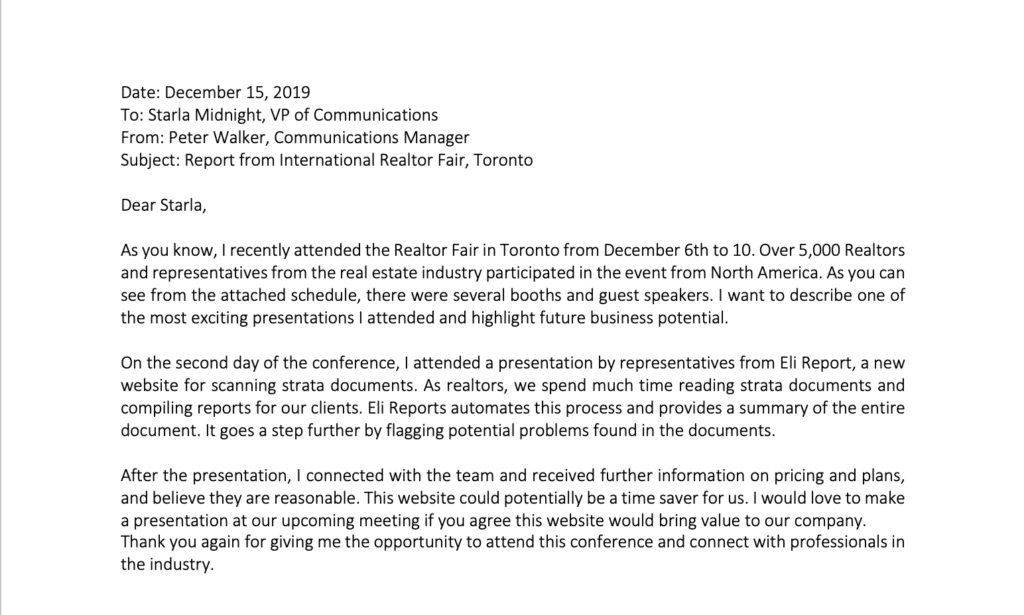
Checklist for Conference Reports
As you reread and revise your conference report, keep in mind the following:
- Write a good introduction explaining the relevant background information
- Include highlights from important speakers or conference workshops
- Explain how the information impacts your business
- Use lists or headings to organize the information
Summary Report
A summary report is used to give management information. For example, if you work in the marketing department, your boss might ask you to find out about your competitors’ online activities so that your company can effectively compete with them. To do this, you would research your competitors’ websites, social media profiles, digital advertising campaigns, and so on. You would then distill what you find down to the key points so that your boss can get the essential information in a short time, and then decide how to act on it. The summary report focuses on the facts, leaving it to management to decide on a course of action.
When you prepare a summary report:
- Read the source information carefully
- Highlight the most important points as per the request
- Write your first draft
- Check your document against the source to ensure your summary is accurate
In general, the main point that you are making in summary reports is that you have done enough research and have used appropriate sources and that you have organized this information in a logical and useful manner. Figure 12.3 illustrates an example of a summary report.
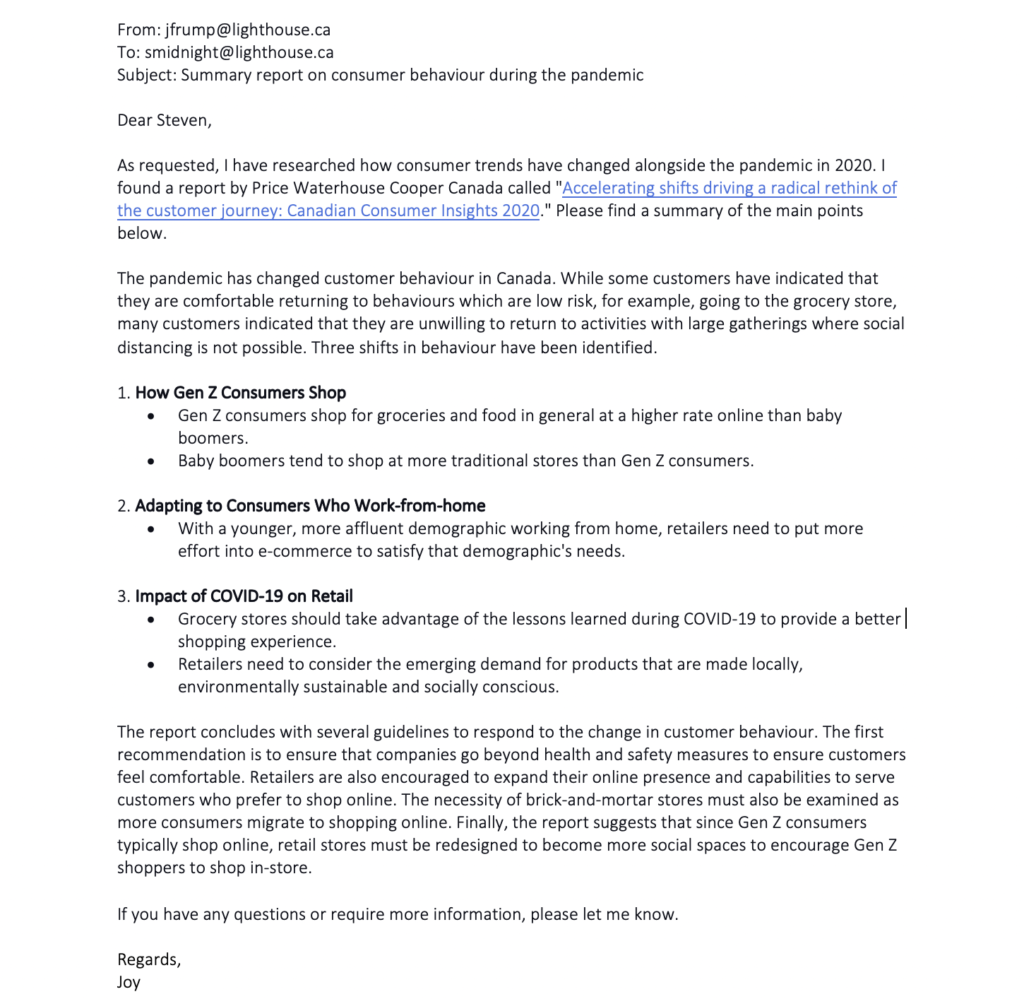
Checklist for Summary Reports
As you reread and revise your summary report, keep in mind the following:
- Write a good introduction highlighting the source(s) which will be included in your summary
- Think about the needs of the audience in determining the length of your summary
- Check your version against the original to ensure there is no misrepresentation of information
- Proofread and revise for grammar, mechanics and style
Progress Reports
You write a progress report to inform a supervisor, associate, or customer about progress you’ve made on a project over a certain period of time. The project can be the design, construction, or repair of something, the study or research of a problem or question, or the gathering of information on a technical subject. You write progress reports when it takes well over three or four months to complete a project.
Contents and Functions of Progress Reports
In the progress report, you explain any or all of the following:
- How much of the work is complete
- What part of the work is currently in progress
- What work remains to be done
- What problems or unexpected issues, if any, have arisen
- How the project is going in general
Progress reports have several important functions:
- Reassure recipients that you are making progress, that the project is going smoothly, and that it will be completed by the expected date.
- Provide recipients with a brief look at some of the findings or some of the work of the project.
- Give recipients a chance to evaluate your work on the project and to request changes.
- Give you a chance to discuss problems in the project and thus to forewarn recipients.
- Force you to establish a work schedule so that you’ll complete the project on time.
- Project a sense of professionalism to your work and your organization.
Timing and Format of Progress Reports
In a year-long project, there are customarily three progress reports, one after three, six, and nine months. Depending on the size of the progress report, the length and importance of the project, and the recipient, the progress report can take the following forms:
- Memo: A short, informal report to someone within your organization
- Letter: A short, informal report sent to someone outside your organization
- Formal Report: A formal report sent to someone outside your organization
Organizational Patterns for Progress Reports
In your progress report, you need (a) an introduction that reviews the purpose and scope of the project, (b) a detailed description of your project and its history, and (c) an overall appraisal of the project to date, which usually acts as the conclusion. Figure 12.4 provides an example of a progress report.
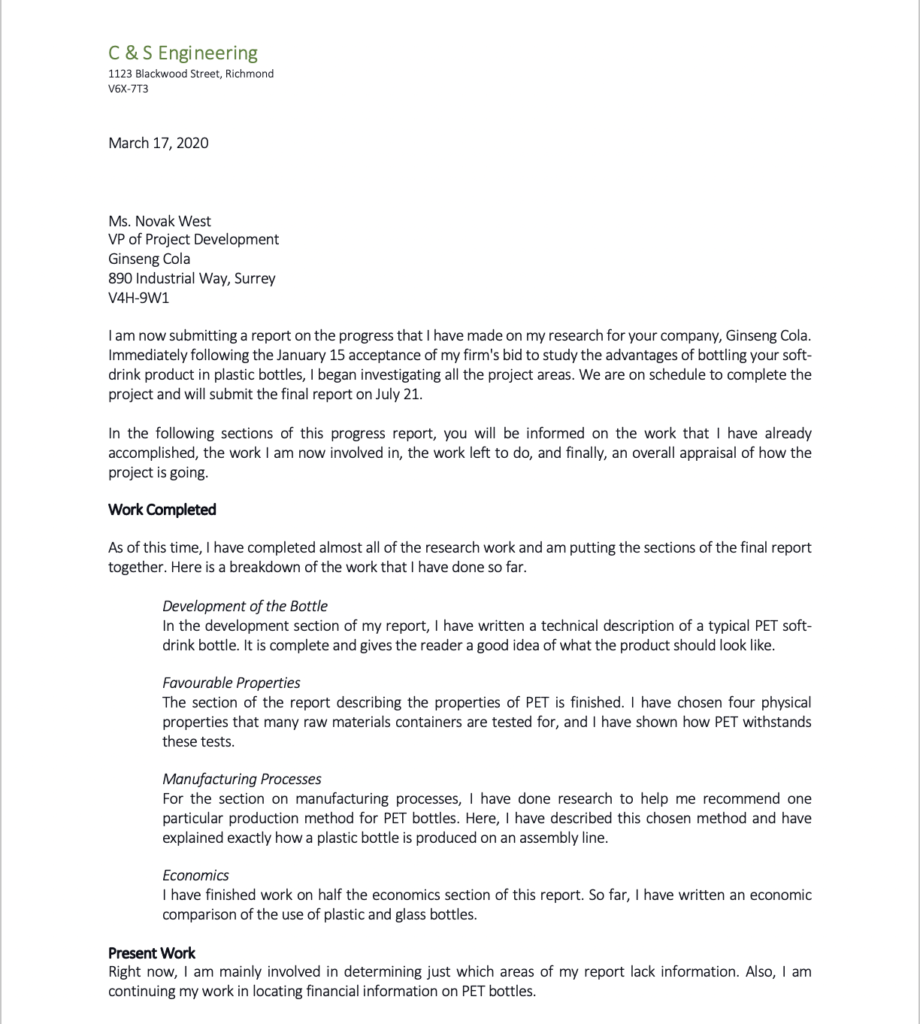

Introduction
In the introduction, review the details of your project’s purpose, scope, and activities. This will aid recipients who are unfamiliar with the project, who do not remember certain details, or who want to doublecheck your approach to the project. The introduction can contain the following:
- Purpose of the project
- Specific objectives of the project
- Scope, or limits, of the project
- Date the project began; date the project is scheduled to be completed
- People or organization working on the project
- People or organization for whom the project is being done
- Overview of the contents of the progress report
Project Description
The project description usually summarizes work within each of the following:
- Work accomplished in the preceding period(s)
- Work currently being performed
- Work planned for the next period(s)
Conclusion
The final paragraph or section usually reassures audiences that all is going well and on schedule. It can also alert recipients to unexpected changes or problems in the project.
Revision Checklist for Progress Reports
As you reread and revise your progress report, keep in mind the following:
- Make sure you use the right format. Remember, the memo format is for internal progress reports; the business-letter format is for progress reports written from one external organization to another.
- Write a good introduction—in it, state that this is a progress report, and provide an overview of the contents of the progress report.
- Make sure to include a description of the final completed project.
- Use headings to mark off the different parts of your progress report, particularly the different parts of your summary of work done on the project.
- Use lists as appropriate.
- Provide specifics—avoid relying on vague, overly general statements about the work you’ve done on the final report project.
- Make sure the report is written in language accessible to your audience.
- Proofread and revise for grammar, mechanics and style
Recommendation Reports
Recommendation reports provide carefully studied opinions and recommendations. This type of report starts from a stated need, a selection of choices, or both and then recommends one, some, or none. For example, a company might be looking at grammar-checking software and want a recommendation on which product is the best. As the report writer on this project, you could study the market for this type of application and recommend one particular product, a couple of products (differing perhaps in their strengths and their weaknesses), or none (maybe none of them are any good). The recommendation report answers the question “Which option should we choose?” (or in some cases “Which are the best options?) by recommending Product A, or maybe both Products A and B, or none of the products.
Organizational Plans for Recommendation Reports
Recommendation reports are generally organized in one of two ways (see Figure 12.5):
- Traditional plan: You start with background and requirements, then move to comparisons, and end with conclusions and recommendations.
- Executive plan: This one moves the conclusions and recommendations to the front of the report and pitches the full discussion of background, requirements, and the comparisons into appendices. That way, the “busy executive” can see the most important information right away, and turn to the detailed discussion only if there are questions.
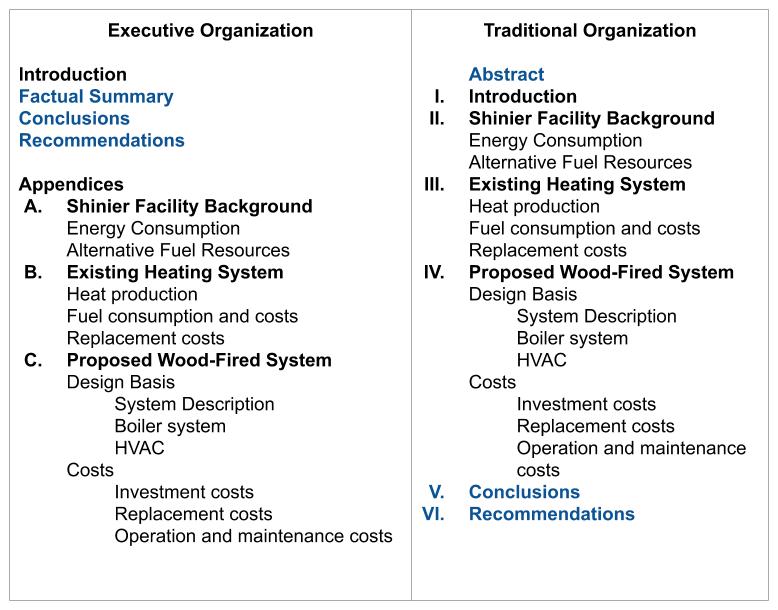
Typical Contents of Recommendation Reports
The structural principle fundamental to this type of report is this: you provide not only your recommendation, choice, or judgment, but also the data and the conclusions leading up to it. That way, readers can check your findings, your logic, and your conclusions and come up with a completely different view. But, more likely, they will be convinced by all your careful research and documentation. The report can be organized using the Whole to Whole approach from Figure 12.6 or the Point by Point approach shown in Figure 12.8. Both approaches will be discussed in more detail in the next section.
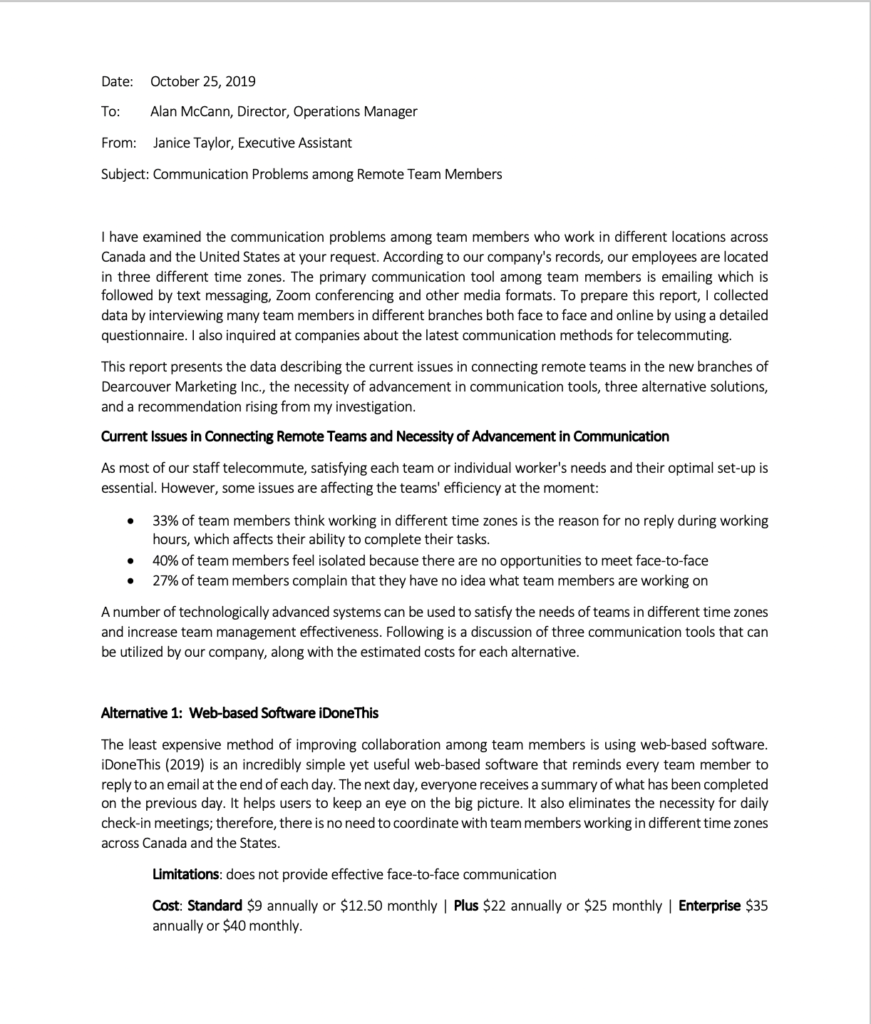
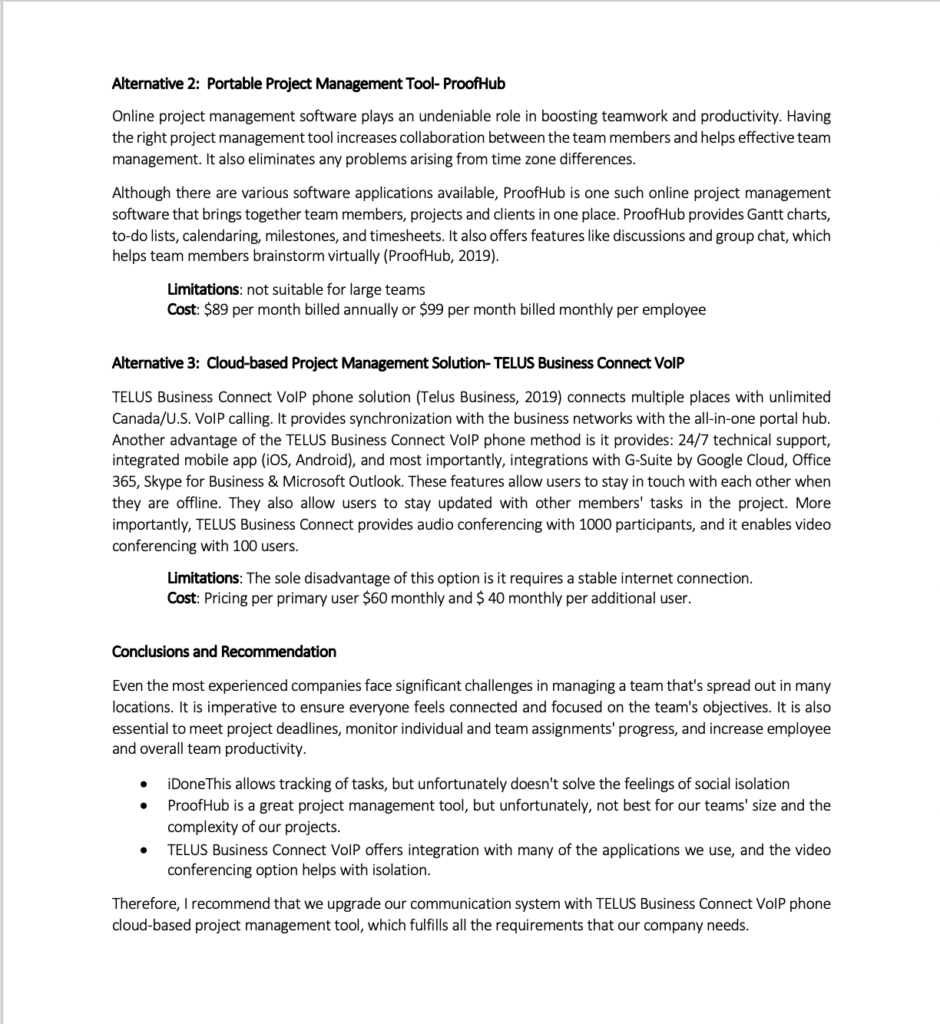
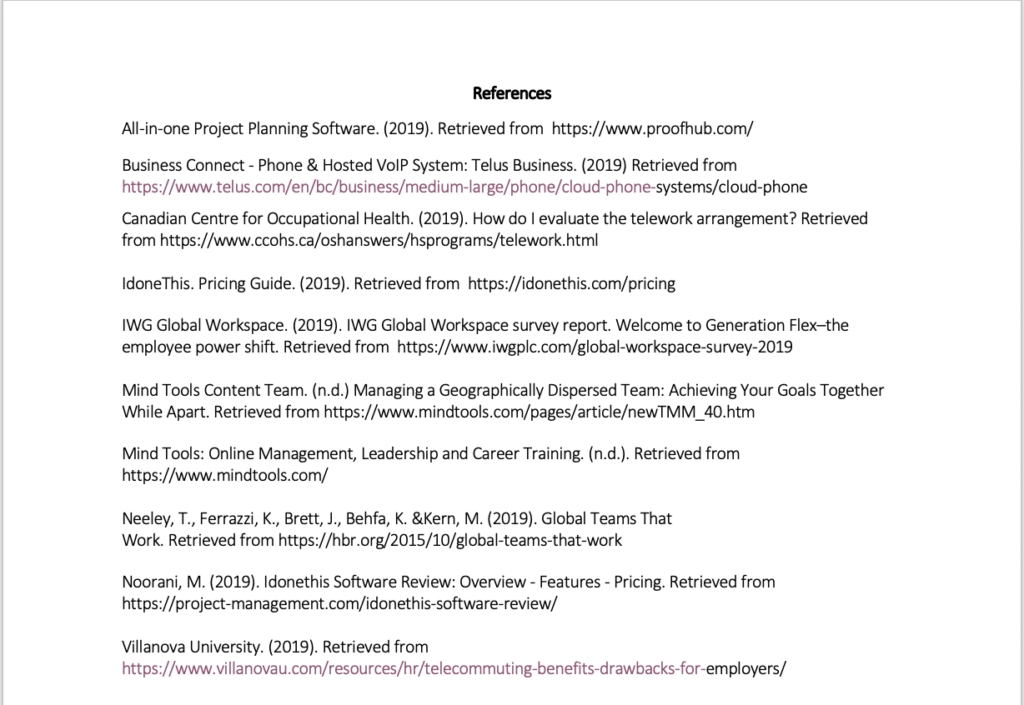
Introduction
In the introduction, indicate the purpose of the report: discuss the problem, need, or opportunity that has brought about the report. In addition, briefly explain the data collection method.
Significance of Situation
Explain how this problem or situation affects your organization and the importance of finding a solution. Do research to build a strong argument around the impact of the problem.
Requirements and Criteria
A critical part of recommendation reports is the discussion of the requirements you’ll use to reach the final decision or recommendation. For example, if you’re trying to recommend a tablet computer for use by employees, your requirements are likely to involve size, cost, hard-disk storage, display quality, durability, and battery function.
The requirements section should also discuss how important the individual requirements are in relation to each other. Picture the typical situation where no one option is best in all categories of comparison. One option is cheaper; another has more functions; one has better ease-of-use ratings; another is known to be more durable. Set up your requirements so that they dictate a “winner” from a situation where there is no obvious winner.
Discussion of the Options
In certain kinds of recommendation reports, you’ll need to explain how you narrowed the field of choices down to the ones you focus on in your report. Often, this follows right after the discussion of the requirements. Your basic requirements may well narrow the field down for you. But there may be other considerations that disqualify other options—explain these as well.
Additionally, you may need to provide brief descriptions of the options themselves. Don’t get this mixed up with the comparison that comes up in the next section. In this description section, you provide a general discussion of the options so that readers will know something about them. The discussion at this stage is not comparative. It’s just a general orientation to the options. In the tablets example, you might want to give some brief, general specifications on each model about to be compared.
Comparison Approaches
One of the most important parts of a recommendation report is the comparison of the options. Remember that you include this section so that readers can check your thinking and come up with different conclusions if they desire. This can be handled with a comparative point by point option or a comparative whole to whole option depending on the situation. Figure 12.7 compares both approaches.
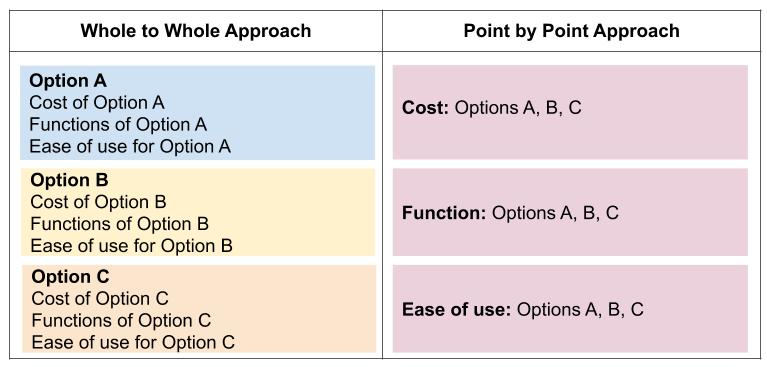
When do you use the point by point approach? The point-by-point approach is effective when the alternatives can be broken down into categories. If you are comparing tablets, you’d have a section that compared them on cost, another section that compared them on battery function, and so on. You wouldn’t have a section that discussed everything about option A, another that discussed everything about option B, and so on. That would not be effective at all, because the comparisons must still be made somewhere—probably by the reader. With the point-by-point approach, each of these comparative sections should end with a conclusion that states which option is the best choice in that particular point of comparison. Of course, it won’t always be easy to state a clear winner—you may have to qualify the conclusions in various ways, providing multiple conclusions for different conditions.
When do you use the whole to whole approach? The whole to whole approach is useful when the comparisons don’t break down logically into points or categories. The options being compared might have different advantages and disadvantages that are not comparable. In this situation, it is best to describe each option in detail, including the advantages, limitations and costs (is applicable). In the conclusion, you’d include comparison and analysis of the different options.
Summary table
After the individual comparisons, include a summary table that summarizes the conclusions from the comparison section, if appropriate. Some readers are prone to pay attention to details in a table rather than in paragraphs.
Conclusions
The conclusions section of a recommendation report is in part a summary or restatement of the conclusions you have already reached in the comparison sections. In this section, you restate the individual conclusions, for example, which model had the best price, which had the best battery function, and so on. This section must untangle all the conflicting conclusions and somehow reach the final conclusion, which is the one that states which is the best choice. For example, if one tablet is the least expensive but has poor battery function, but another is the most expensive and has good battery function, which do you choose, and why? The conclusion would state the answer to this dilemma.
Recommendation
The final section of a recommendation report states the recommendation. You’d think that that ought to be obvious by now. Ordinarily it is, but remember that some readers may skip right to the recommendation section and bypass all your hard work! Also, there will be some cases where there may be a best choice, but you wouldn’t want to recommend it. Early in their history, laptop computers were heavy and unreliable. There may have been one model that was better than the rest, but even it was not worth having. The recommendation section should echo the most important conclusions leading to the recommendation and then state the recommendation emphatically as demonstrated in Figure 12.8.
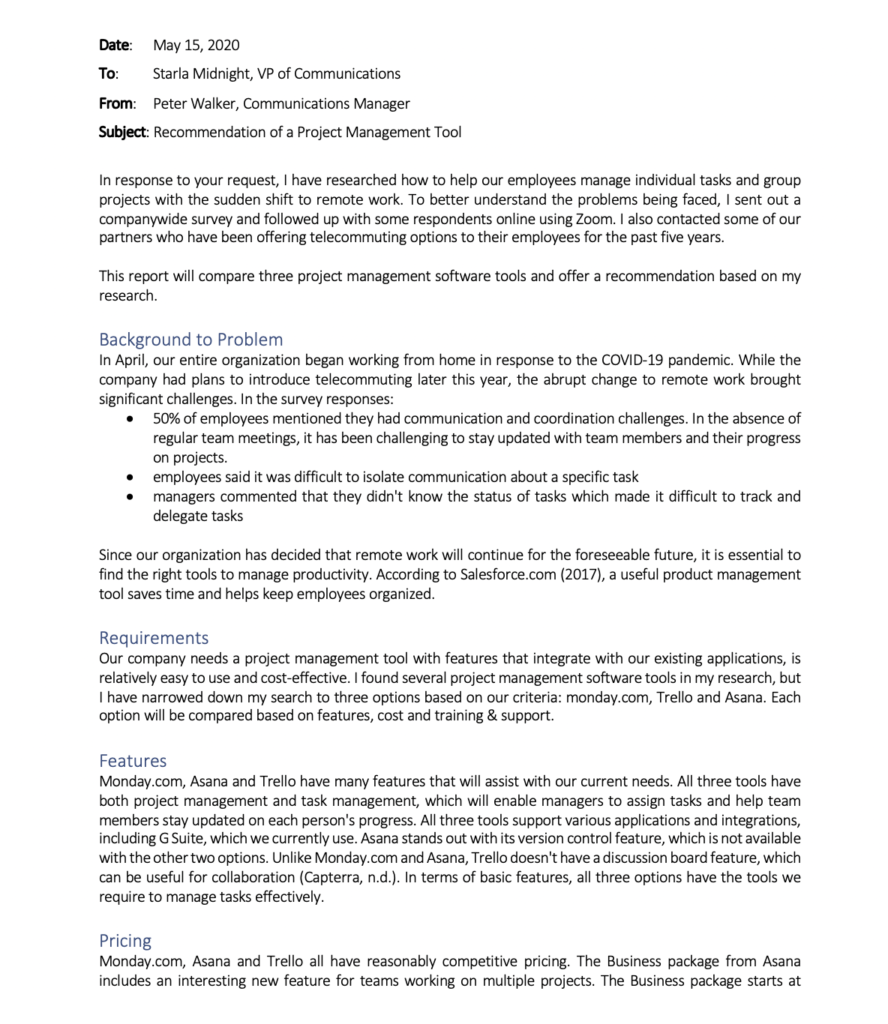
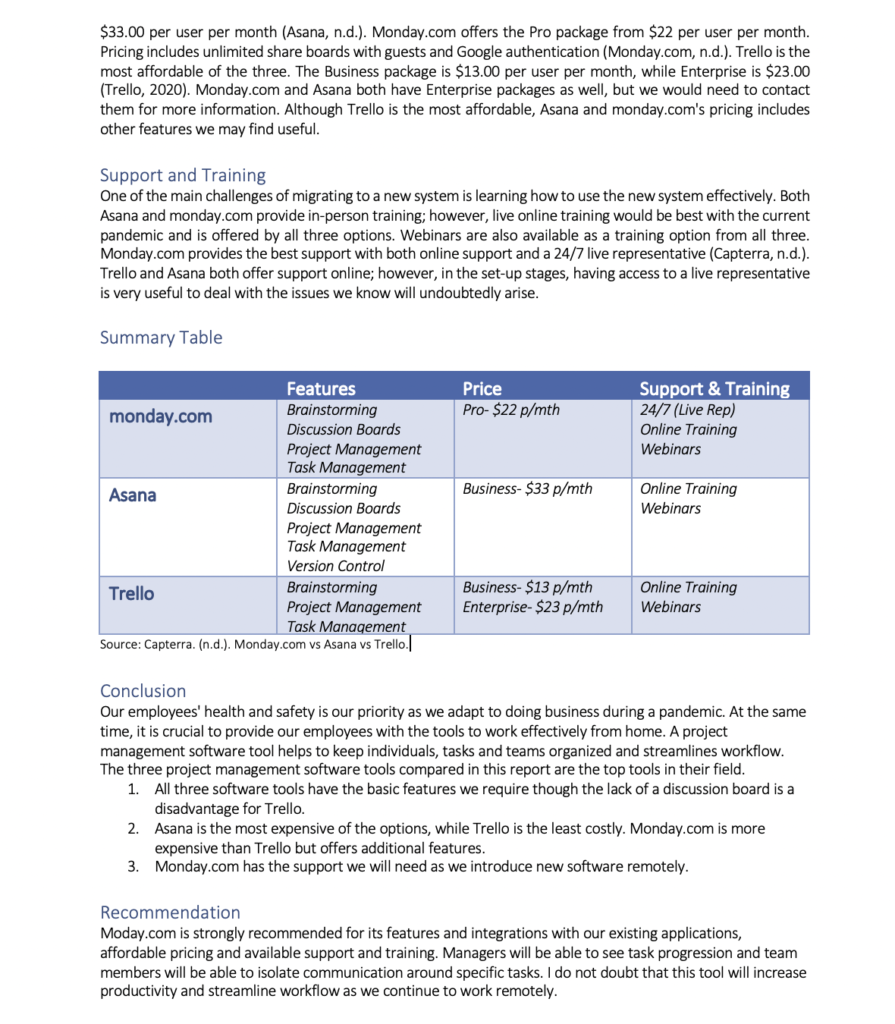
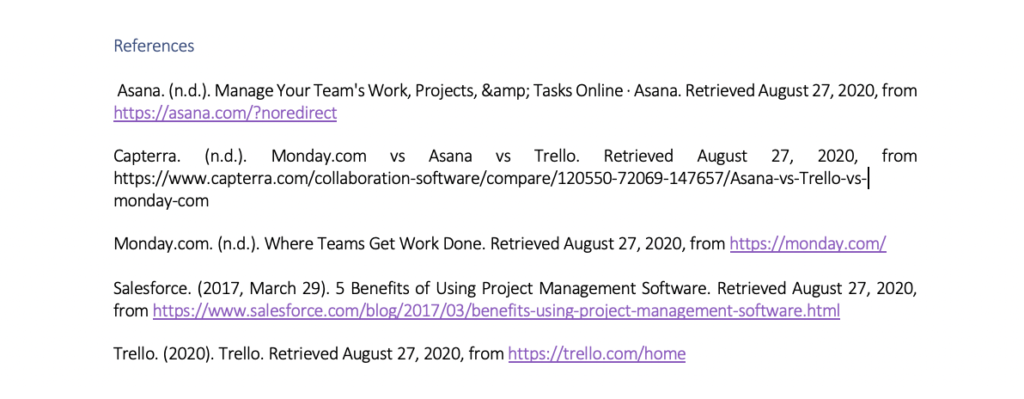
Figure 12.8 | Recommendation Report- Point by Point Approach
Checklist for Recommendation Reports
As you reread and revise your recommendation report, keep in mind the following:
- Write a good introduction in which you indicate the situation and the audience and provide an overview of the contents.
- Discuss the background on the problem or opportunity—what brought about the need for the report.
- State requirements—those factors that influence the decision or the choice of options. (And remember to state how important the requirements are in relation to each other.)
- Organize the comparison of the options using the point by point approach or whole to whole approach.
- Include a summary table, if possible, in which you summarize all the key data in table form.
- Include a conclusions section where you restate all the key conclusions from the comparison section.
- Include a recommendation section where you make the recommendation. Briefly mention the key factors influencing the recommendation.
- Include your references section so that the reader can refer to your sources.
- Proofread and revise for grammar, mechanics and style
Summary
This chapter focuses on the organizational structure for some common types of business reports. Regardless of the type of report you write, make sure the purpose is clear, the content matches audience expectations and the information is organized in a logical manner.
End of Chapter Activities
12a. Thinking About the Content
What are your key takeaways from this chapter? What is something you have learned or something you would like to add from your experience?
12b. Discussion Questions
Discussion Questions
- Do you have experience writing any of the reports mentioned in this chapter?
- Which report would you find most difficult to write?
- Discuss a report on a trend in business that you’ve observed, and highlight at least the main finding. For example, from the rising cost of textbooks to the online approach to course content, textbooks are a significant issue for students. Draw from your experience as you bring together sources of information to illustrate a trend. Share and compare with classmates.
12c. Applying chapter concepts to a situation
Recommending A New Office Printer
Atwood Financial Services is a locally owned company that offers short-term loans and foreign exchange services to Canadians. They have new requests daily, and the staff are required to print contracts and receipts for each transaction. They are unable to offer services without a functional printer.
Recently, the printer has stopped working due to the high volume of printing that occurs in the office. Lisa Atwood, the owner at AFS, decides it’s time to upgrade to a new device instead of repairing the one they currently have. She asks Tito, the purchasing manager, to write a report recommending a new printer that has the following features:
- Makes black and white and colour copies
- Scans and sends documents to email
- Requires a keycard for login purposes in addition to user ID and password.
- Is competitively priced
From Tito’s experience with writing previous reports for Lisa, he knows that she prefers when tables are included.
Create a table comparing three brands of printers based on Lisa’s suggested features.
12d. Writing Activity
Watch this video from TED.com on The Hidden Opportunities of the Informal Market. Summarize the video. What do you think about this report on the informal market?
Attribution
This chapter contains information from Business Communication for Success, which is adapted from a work produced and distributed under a Creative Commons license (CC BY-NC-SA) in 2010 by a publisher who has requested that they and the original author not receive attribution. This adapted edition is produced by the University of Minnesota Libraries Publishing through the eLearning Support Initiative, Business Communication For Everyone (c) 2019 by Arley Cruthers and is licensed under a Creative Commons-Attribution-NonCommercial-ShareAlike 4.0 International license, and Online Technical Writing by David McMurrey and is licensed under a Creative Commons Attribution 4.0 International License.

